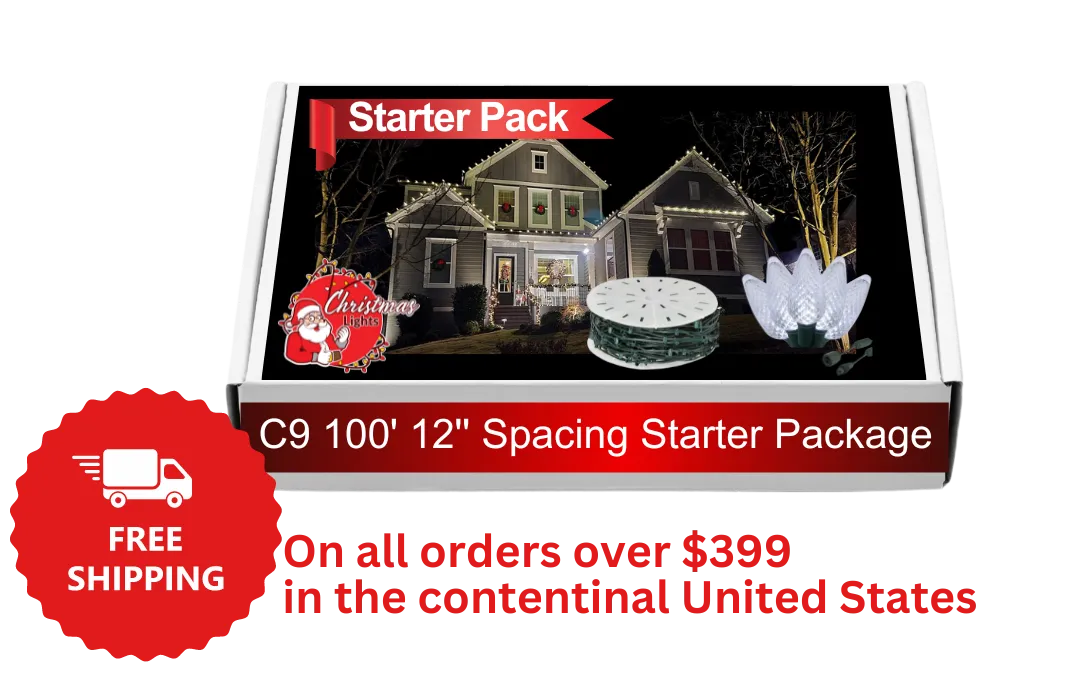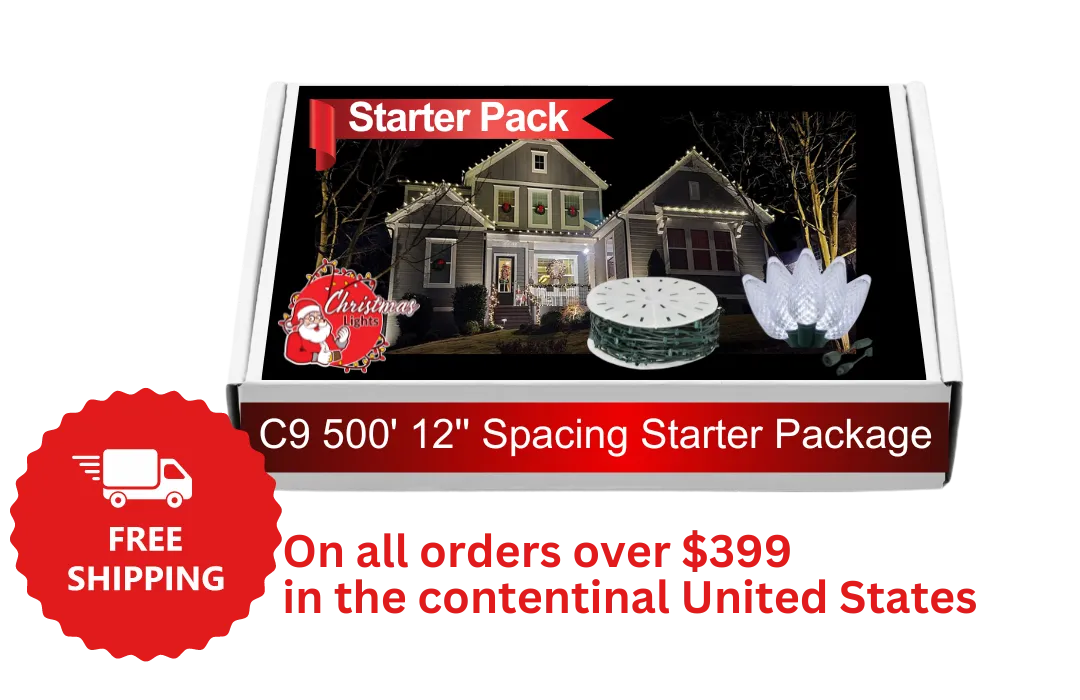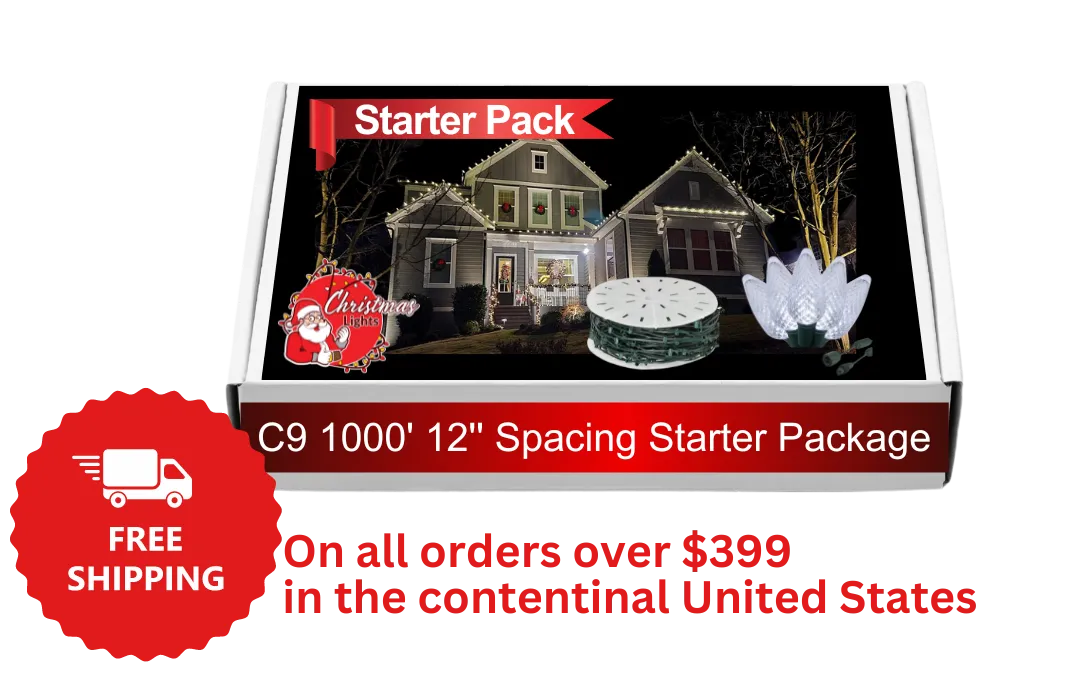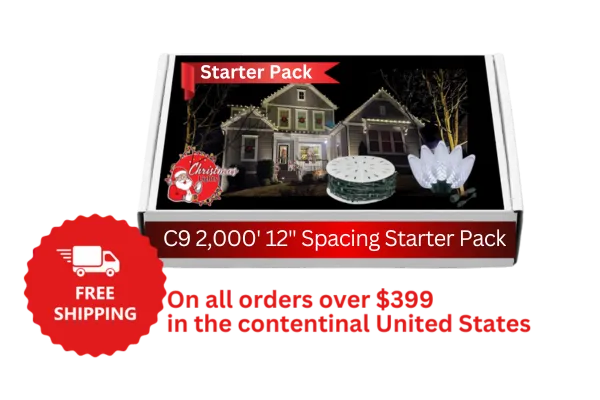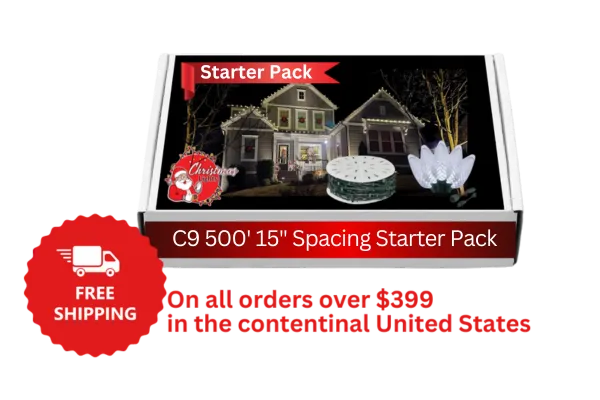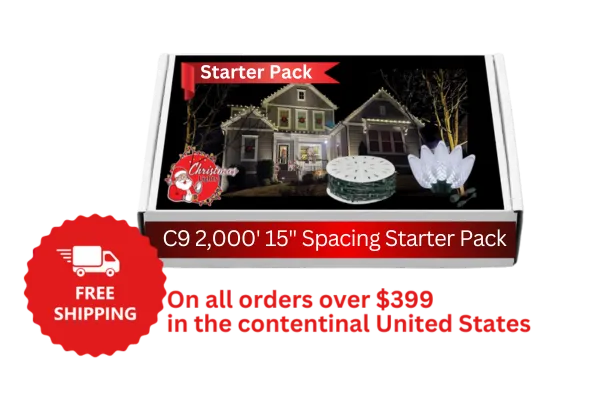Kickstart Your Christmas Lights Installation Business
with Our All-Inclusive Premium Starter Kits
C9 Christmas Lights Starter Packs 12" Spacing
C9 Christmas Lights Starter Packs 15" Spacing
Frequently Asked Questions
What is included in the Christmas Lights starter pack?
The Christmas Lights starter pack is a comprehensive kit that provides everything you need to get started with your holiday lighting project. It includes all the necessary components, such as clips, male and female plugs, and an extra extension cord.
What specific items are included in the 1000 foot 15" C9 Christmas Lights starter pack?
The 1000 foot starter pack C9 15' spacing package includes the following items:
800 C9 LED Bulbs: These energy-efficient bulbs are the main component of your lighting display, providing bright and vibrant illumination.
800 Best Clips: These clips are designed to securely attach your light strings to various surfaces, ensuring a stable and professional-looking installation.
1000' Green 15" Spacing Socket Spool: This spool contains 1000 feet of green wire with sockets spaced every 15 inches, allowing for even distribution of your C9 bulbs.
250' Green Lamp Cord: This additional lamp cord provides extra length for your lighting setup, enabling you to cover larger areas or create extended displays.
50 Green Male Plugs: These plugs are used to connect your light strings to power sources or to join multiple strings together.
50 Green Female Plugs: These plugs are used to create a seamless connection between your light strings, allowing for a continuous and uninterrupted display.
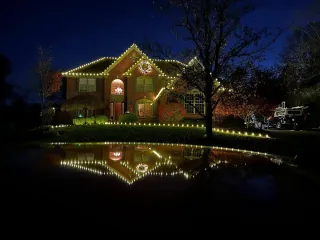
How many houses can I typically light up with a single 1000 foot starter pack?
On average, a 1000 foot starter pack is sufficient to light up approximately 5 to 6 houses, depending on the size and layout of each property.
This estimation is based on the standard components included in the starter pack, such as the 800 C9 LED bulbs and the 1000 feet of socket spool.Headline
However, it's important to keep in mind that every project is unique, and the actual number of houses you can illuminate with a single starter pack may vary.
Factors such as the complexity of the designs, the distance between installation points, and the specific requirements of each client can all impact the coverage of the starter pack.
To ensure a smooth installation process and to accommodate any additional wiring needs, it's always a good idea to have some extra lamp cord on hand for extension purposes.
You may also want to stock up on extra female plugs to facilitate connections between multiple strands of lights or to create custom lengths as needed.
By being prepared with these additional components, you can easily adapt to the specific demands of each project and ensure that you have the flexibility to create stunning and professional-looking lighting displays, regardless of the number of houses you're working on.

Discover Expert Tips on Our Blog

Yes, People Pay $2000+ for Christmas Lights (Here's How to Find Them)
Starting a Christmas lighting business might seem like a seasonal side hustle, but industry veterans are proving it can become a substantial year-round enterprise. Successful entrepreneurs in this field are generating six-figure revenues and beyond by following proven strategies and avoiding common pitfalls that trap most contractors in low-profit cycles.
The Foundation: Understanding Your True Business Costs
One of the biggest mistakes new business owners make is failing to understand what it actually costs to run their business. Too many entrepreneurs look at a $500 job that took two hours and think they've made easy money, completely forgetting about the hidden costs that eat into profits.
Every job requires significant investment that goes far beyond direct labor and materials. This includes advertising expenses to generate leads, the time spent working inside the business outside of billable hours, fuel costs, insurance premiums, and taxes. Many business owners overlook these crucial expenses, leading to pricing that's unsustainable in the long run.
A perfect example of this miscalculation involves a young contractor who claimed to make $600 profit on a $2,000 concrete job after paying for materials and labor. However, this contractor failed to account for insurance, taxes, advertising costs, contract negotiation time, and numerous other business expenses that would have significantly reduced or eliminated his actual profit.
Understanding these hidden costs is crucial because they often represent 30-50% of your total business expenses. Without factoring them into your pricing, you're essentially working for free or even losing money on each job.
Breaking the Low-Price Mindset
Many Christmas lighting contractors struggle with charging premium prices, often because they're focused on what competitors charge rather than the value they provide. Successful contractors charge $7-10 per foot even when local competitors charge significantly less, with some advertising basic $300 installations.
The key to commanding higher prices isn't about ignoring the competition—it's about providing superior value. Most contractors can't command premium prices because they're not worth it. The quality of their product, service, delivery, and installation doesn't justify higher pricing.
Instead of competing on price, focus on becoming an expert in your field. Don't follow the same path everyone else has taken. Create value through superior customer service, better designs, higher quality installations, and professional marketing materials. When you consistently deliver more value than competitors, premium pricing becomes justified and sustainable.
The Power of Premium Pricing
Successful Christmas lighting businesses routinely achieve $2,000 to $3,000 average tickets, with some reaching $5,000 in certain markets. Industry leaders maintain close to $3,000 average tickets, while businesses in premium markets like Florida achieve $5,000 averages.
This isn't about overcharging—it's about understanding the true value proposition. For many clients, a $2,000 Christmas lighting installation represents an investment in family memories, safety (avoiding dangerous ladder work), and convenience that's easily justified when positioned correctly.
The difference between a $400 average ticket and a $2,000 average ticket isn't just pricing—it's an entirely different business model. Higher-ticket businesses can afford better marketing, superior customer service, and more systematic operations that create sustainable competitive advantages.
Mindset: The Make-or-Break Factor
Many successful contractors started by basing their pricing on competitors rather than value. This approach initially seems logical but creates fundamental problems. When you provide superior service—better customer service, higher quality designs, better delivery, and superior marketing materials—while charging the same prices as inferior competitors, you're actually losing money.
The transformation comes when contractors realize they don't always have to break a sweat or strain their backs to accomplish great things in business. While physical work has its place, focusing on specific areas of the business and being intentional about activities creates much better results than trying to do everything yourself.
This mindset shift extends to employee compensation. Many contractors think they can't pay employees well because they themselves aren't making much money. However, when you build proper systems and remove yourself from day-to-day operations, you can often pay employees more than you made when working in the business yourself.
Getting Off the Truck: The Critical Transition
One of the most challenging but necessary transitions for any service business owner is moving from technician to business owner. Staying on the truck (doing the installations yourself) limits your business to a $20-30 per hour value, regardless of what you charge customers.
This transition requires both mindset shifts and systematic approaches. You must believe that others can do the work effectively, and you must create systems that enable consistent quality without your direct involvement.
The urgency of this transition becomes clear when you consider what happens if you get injured. Many contractors have seen their businesses collapse when the owner couldn't perform the work due to injury. Building a business that can operate without you isn't just about growth—it's about sustainability and risk management.
Most entrepreneurs start businesses because they're hard workers, but this strength can become a weakness if it prevents them from building scalable systems. The goal should be to work on your business, not just in it.
Building Systems for Scale
Creating scalable systems involves more than just hiring people—it requires documented processes, training materials, and quality control measures. Successful contractors create extensive video libraries showing proper installation techniques, compiled from various training sources and internal expertise.
These systems enable business owners to maintain quality standards while removing themselves from day-to-day operations. More importantly, they allow employees to become better at specialized roles than the owner ever was, since they can focus entirely on their specific area of expertise.
Effective systems include written procedures, video training materials, quality checklists, and clear accountability measures. Without these elements, attempts to scale typically result in quality problems and customer dissatisfaction.
The key is understanding that if you don't have systems and checklists, you can't effectively evaluate whether work is being done correctly. Systems create the foundation for consistent quality and profitable growth.
The Marketing Mix: Yard Signs vs. Digital
When discussing marketing strategies, yard signs emerge as the standout performer for Christmas lighting businesses. Despite the digital marketing boom, yard signs remain some of the cheapest and most effective advertising possible for local service businesses.
The key to effective yard sign marketing lies in design and placement. Avoid overly complicated designs with too much information. Instead, focus on what you do and how to contact you. Place signs in areas where your ideal customers shop and live, not just anywhere that allows signage.
Design matters significantly. Most people complicate yard signs by including too much information. Generally speaking, it doesn't matter if your logo or name is prominently featured—focus on the service you provide and how to contact you. Keep the message simple and clear.
Digital marketing, including Facebook and Google ads, can supplement yard signs effectively, but the tried-and-true method of yard signs consistently delivers strong results for this industry. The average person sees a yard sign for only three seconds, so your message must be immediately clear and memorable.
The Permanent Lighting Consideration
Permanent lighting represents an emerging market segment worth considering. While traditional Christmas lights remain preferred for residential holiday installations, permanent lights offer significant opportunities, particularly in commercial applications.
Commercial clients want competitive advantages, and permanent lighting systems allow businesses to differentiate themselves year-round while providing architectural enhancement and security benefits beyond seasonal decoration.
However, quality concerns with some permanent lighting products have created opportunities for contractors who can deliver superior installations and customer service. Some early permanent lighting systems have developed quality issues, turning blue or failing partially, which creates selling opportunities for contractors offering better solutions.
For residential applications, permanent lighting adoption varies significantly by market. Some areas like Utah show high adoption rates with multiple permanent lighting installations visible on every street, while other markets show much slower adoption.
Investment in Education and Networking
Successful contractors consistently invest in education and surround themselves with other successful people. The mindset shift happens naturally when you interact with people operating at higher levels than your current situation.
This principle extends to investing in training and professional development. Contractors who achieve significant success typically participate in industry training events where they can learn installation techniques, business systems, marketing strategies, and network with successful peers.
The networking aspect often proves more valuable than the formal training content. The knowledge shared during informal interactions and dinner conversations can be worth exponentially more than the cost of attending educational events.
However, simply attending training isn't enough. You must also buy your own product to truly understand the value you're providing. Many contractors struggle to sell premium services because they don't personally experience what their customers receive. When you invest in your own product, you naturally become more confident in its value.
Overcoming Market Objections
When other contractors in your market charge significantly less, you must overcome pricing objections through superior marketing and positioning. You'll need to out-market competitors and position yourself with the right customers who value quality over price.
This requires understanding your ideal customer. Not everyone needs Christmas lights, and more importantly, not everyone is your ideal client. HVAC contractors might be able to place signs anywhere since everyone needs heating and cooling, but Christmas lighting requires more targeted positioning.
Focus on customers who value the experience, convenience, and quality you provide. These customers exist in every market—you just need to reach them effectively and communicate your value proposition clearly.
Taking Action: From Knowledge to Results
Knowledge without action produces no results. Many people attend training events and read educational content but fail to implement what they learn. Success requires taking concrete steps to apply new knowledge consistently.
The Christmas lighting industry provides inspiring examples of contractors who started with limited resources but achieved remarkable success through proper education, systems, and execution. Age and circumstances don't determine success—action and proper guidance do.
Building a successful Christmas lighting business requires more than just knowing how to hang lights. It demands understanding true business costs, developing the right mindset, creating scalable systems, and consistently taking action. The businesses that achieve $2,000+ average tickets and six-figure revenues have mastered these fundamentals while maintaining focus on delivering exceptional value to their customers.
Success in this industry comes down to treating it as a real business, not a seasonal side hustle. This means proper pricing, professional systems, effective marketing, and a commitment to continuous improvement and growth.
Frequently Asked Questions
1. What should my average ticket be for Christmas lighting installations?
Successful Christmas lighting businesses typically achieve $2,000 to $3,000 average tickets, with some markets supporting $5,000+ averages. The key is focusing on value rather than just competing on price. Your average ticket should reflect the true cost of doing business plus appropriate profit margins.
2. How do I justify charging $7-10 per foot when competitors charge much less?
Justify premium pricing through superior quality, service, and value delivery. Focus on being the best at what you do rather than the cheapest. Ensure your customer service, installation quality, design capabilities, and overall experience exceed what lower-priced competitors offer.
3. When should I stop doing installations myself and hire employees?
You should transition off the truck as early as possible. Doing installations yourself limits your business to $20-30 per hour value regardless of what you charge. The sooner you build systems and train others, the faster you can scale. Consider what happens to your business if you get injured and can't work.
4. What are the hidden costs I need to account for in my pricing?
Hidden costs include advertising and lead generation expenses, insurance, taxes, fuel, equipment maintenance, time spent on non-billable activities (quotes, scheduling, bookkeeping), workers' compensation, and vehicle expenses. Many contractors only consider direct labor and materials, which leads to unsustainable pricing.
5. Are yard signs really more effective than digital marketing for Christmas lighting?
Yard signs consistently outperform other marketing methods for Christmas lighting businesses. They're cost-effective, target the right geographic areas, and create immediate local awareness. The key is good design (simple, clear messaging) and strategic placement in areas where your ideal customers live and shop.
6. Should I offer permanent lighting in addition to traditional Christmas lights?
Permanent lighting can be profitable, especially for commercial clients who want year-round architectural lighting and security benefits. However, focus on quality products and installation since some early permanent lighting systems have created quality concerns in the market.
7. How do I overcome the mindset barrier of believing customers won't pay premium prices?
Shift your mindset by understanding your customers' perspective. A $2,000 investment in Christmas lighting provides family memories, safety (avoiding dangerous ladder work), and convenience. For many customers, this represents significant value. Also, surround yourself with other successful contractors who charge premium prices.
8. What's the biggest mistake new Christmas lighting contractors make?
The biggest mistake is basing pricing on competitors rather than understanding true business costs and value provided. This leads to unsustainable pricing that prevents business growth and profitability. Another major mistake is trying to do everything themselves instead of building scalable systems.
9. How important is networking and education for growing my business?
Networking and education are crucial for success. Surrounding yourself with successful contractors naturally shifts your mindset and provides valuable insights. The informal knowledge sharing that happens during networking often proves more valuable than formal training content.
10. Is it too late to start a Christmas lighting business if it's already August?
It's not too late. Many successful contractors have started as late as Halloween weekend and still achieved $30,000+ in their first year, then grown to six figures the following year. Success depends more on proper education, systems, and execution than timing, though earlier preparation allows for better marketing and customer acquisition.
Copyright ©2025 All Right Reserved website designed by christmaslights.io
Terms of Service / Privacy Policy
Have questions or need assistance?
Contact us at (855)619-LITE


